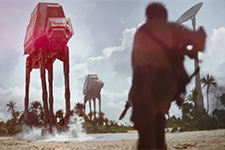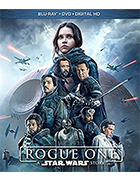Rogue One: A Star Wars Story [Blu-Ray]
|

This review contains some spoilers. Proceed with caution if you have not already seen the film As the first stand-alone live-action feature film in the Star Wars franchise, which is now about to enter its fourth decade, Rogue One has a kind of freedom that its Roman numeral-bearing brethren do not. Filled almost entirely with new characters flanked by a few familiar faces (some of which are CGI creations), it has the benefit of feeling both unique and familiar, although its primary pleasure will be for fans who recognize the various homages to the original trilogy and thrill to the connections it makes with one of the most beloved blockbusters of all time. Fitting neatly into the space between Star Wars: Episode III—Revenge of the Sith (2005), the last of George Lucas's three, often unfairly derided prequels, and Star Wars: Episode IV—A New Hope (1977), the one that started it all, Rogue One fills in the backstory of how the Rebel Alliance learned of, and came into the possession of plans for, the Death Star, the Empire's moon-sized battle station that was eventually capable of blowing up an entire planet. If you've ever wondered exactly how Princess Leia's ship came into possession of the plans and why that Star Destroyer was chasing her down in the opening shots of Star Wars, Rogue One has the answer. Like J.J. Abrams's The Force Awakens (2015), which resuscitated the franchise by going back to the original's look and feel, Rogue One is a much more naturalistic looking film than Lucas's three prequels, which relied heavily—some would argue too heavily—on glistening computer-generated imagery. There is plenty of that here, but it tends to take a back seat to the actual locations, full-sized props, and creatures made of animatronics and prosthetics. Like the original Star Wars, it looks quite analogue, which means that, when CGI shows up, it sometimes stands out in a not so good way (I'm thinking particularly of its use to bring back characters whose actors have either died or grown old, which is sometimes effective, but mostly distracting because CG-created human characters are simply not yet ready for prime time). Director Gareth Edwards (Godzilla) and cinematographer Greig Fraser (Let Me In, Zero Dark Thirty) maintain a look that, until the final half hour at least, is consistently dim and earthen in its tones, which has drawn some criticism from those who consider the look an anomaly, forgetting, of course, that the original Star Wars took place almost entirely on a desert planet and in and around the Death Star with its gleaming, fascistic black and white surfaces. Also like The Force Awakens, Rogue One's protagonist is an orphaned young woman, in this case Jyn Erso (Felicity Jones), whose father, Galen Erso (Mads Mikkelsen), is a weapons engineer who was one of the primary architects of the Death Star. Galen was an unwilling collaborator, having been forced at blaster point to work on the dreaded space station, so he secretly worked to build a fatal flaw into the design, which explains why, in Star Wars, a single proton torpedo shot into a vent could destroy the whole thing. Galen sends an Imperial pilot, Bodhi Rook (Riz Ahmed), to the Rebels with the information, although he must first make his way through an offshoot extremist group run by Saw Gerrera (Forest Whitaker). The Rebels, needing to make contact with Saw, spring Jyn from an Imperial prison because Saw helped her escape 15 years earlier when her father was captured by the Empire. Although at first a reluctant Rebel, Jyn soon becomes a leader, banding together with a small group that includes Cassian Andor (Diego Luna), a longtime Rebel fighter who was tasked with killing her father for collaborating with the Empire; K-2SO (Alan Tudyk), a reprogrammed Imperial droid whose towering, menacing appearance belies a dry sense of humor; Chirrut Îmwe (Hong Kong superstar Donnie Yen), a blind Zatoichi-like warrior who still believes in the Force (remember, this is after Episode III when all the Jedi have supposedly been wiped out), and Chirrut's barrel-chested, gun-toting partner Baze Malbus (Chinese actor/director Wen Jiang). The primary villain is Orson Krennic (Ben Mendelsohn), an officious Imperial officer who is overseeing the construction of the Death Star and is therefore responsible for forcing Galen to work on it and breaking up his family, although Darth Vader makes a few key appearances. The film builds to a well-paced multi-part action sequence in which Jyn and her team are infiltrating an Imperial base to steal the plans to the Death Star while Rebel and Imperial fighters duke it out in the space just above the planet and on and around the planet's lush, tropical surface (Palm trees! Blue water! White sands!). Although it takes a while to build up a head of steam, Rogue One is an admirable entry into the series, partially because visual effects designer-turned-director Gareth Edwards maintains the franchise's swashbuckling sense of rousing adventure, but also grounds it in a darker reality about the true nature of rebellion. In other words, it's not always about grand victory, and even when the righteous freedom fighters carry the day, there are major sacrifices to be made. Short of Revenge of the Sith and The Empire Strikes Back (1980), both of which necessarily end with evil victorious and good temporarily defeated, Rogue One is the darkest of the Star Wars films, and its wears that burden well. There might be a tendency to bemoan its moral weightiness, which might have worn better had the characters been more rounded and interesting. The film is at a fundamental disadvantage because it doesn't allow us to easily connect to characters we already know and admire or loathe, instead presenting us with a whole gaggle of new faces who must earn their keep. Felicity Jones makes for a plucky and intriguing rebel-heroine, although she doesn't have much depth of character; she is mainly a cog in a much larger machine, going through the motions to make the plot happen without much promise of anything beyond the scrolling credits. The same could be said for Luna's Cassian Andor, who is often stuck in the position of having to make big speeches and struggle with ethical choices regarding the nature of revolutionary violence. The film dabbles with such weighty ideas, but never really delves into them, perhaps because the screenwriters—Chris Weitz (Cinderella) and Tony Gilroy (Michael Clayton, the Bourne series), working from a story by visual effect supervisor John Knoll and Gary Whitta (The Book of Eli, After Earth)—know we're already invested in the Rebel Alliance's fight against the Galactic Empire. Even with all the backstory already established and big themes fully cemented, there is still quite a bit of plot to slog through, and if Rogue One has a weakness, it is that it takes too long to get rolling. Those with patience will find that its second half is fully rewarding, with its epic battles and grand conflicts between good and evil bearing most of the weight of the astronomical expectations that are now part and parcel of the franchise. I doubt it will go down as one of the most beloved Star Wars entries, but it is hard to argue that, on its own terms, it doesn't work pretty well.
Copyright © 2017 James Kendrick Thoughts? E-mail James Kendrick All images copyright © Lucasfilm Ltd. | |||||||||||||||||||||||||||||||
Overall Rating:



 (3.5)
(3.5)
Subscribe and Follow
Get a daily dose of Africa Leader news through our daily email, its complimentary and keeps you fully up to date with world and business news as well.
News RELEASES
Publish news of your business, community or sports group, personnel appointments, major event and more by submitting a news release to Africa Leader.
More Information
